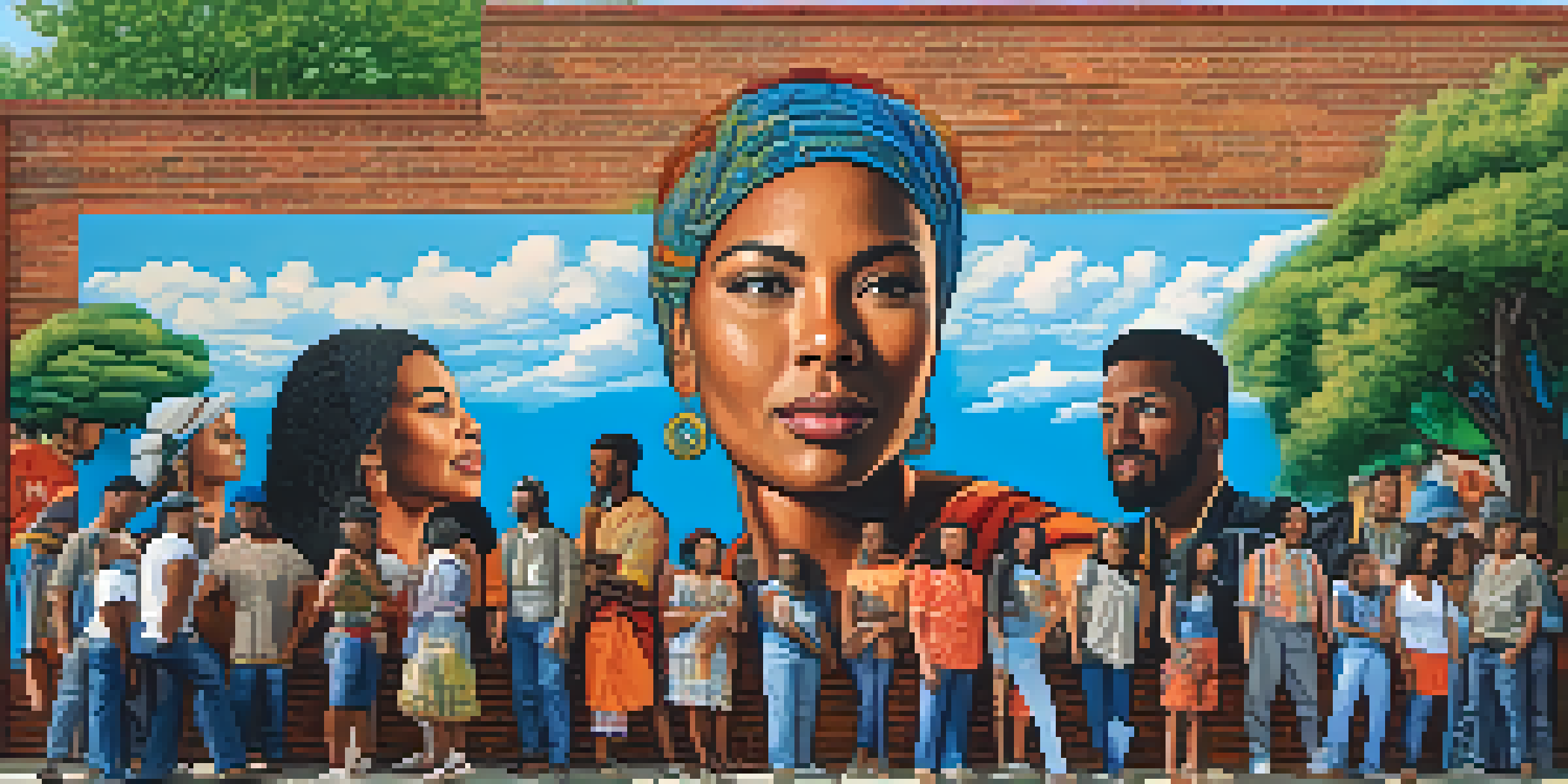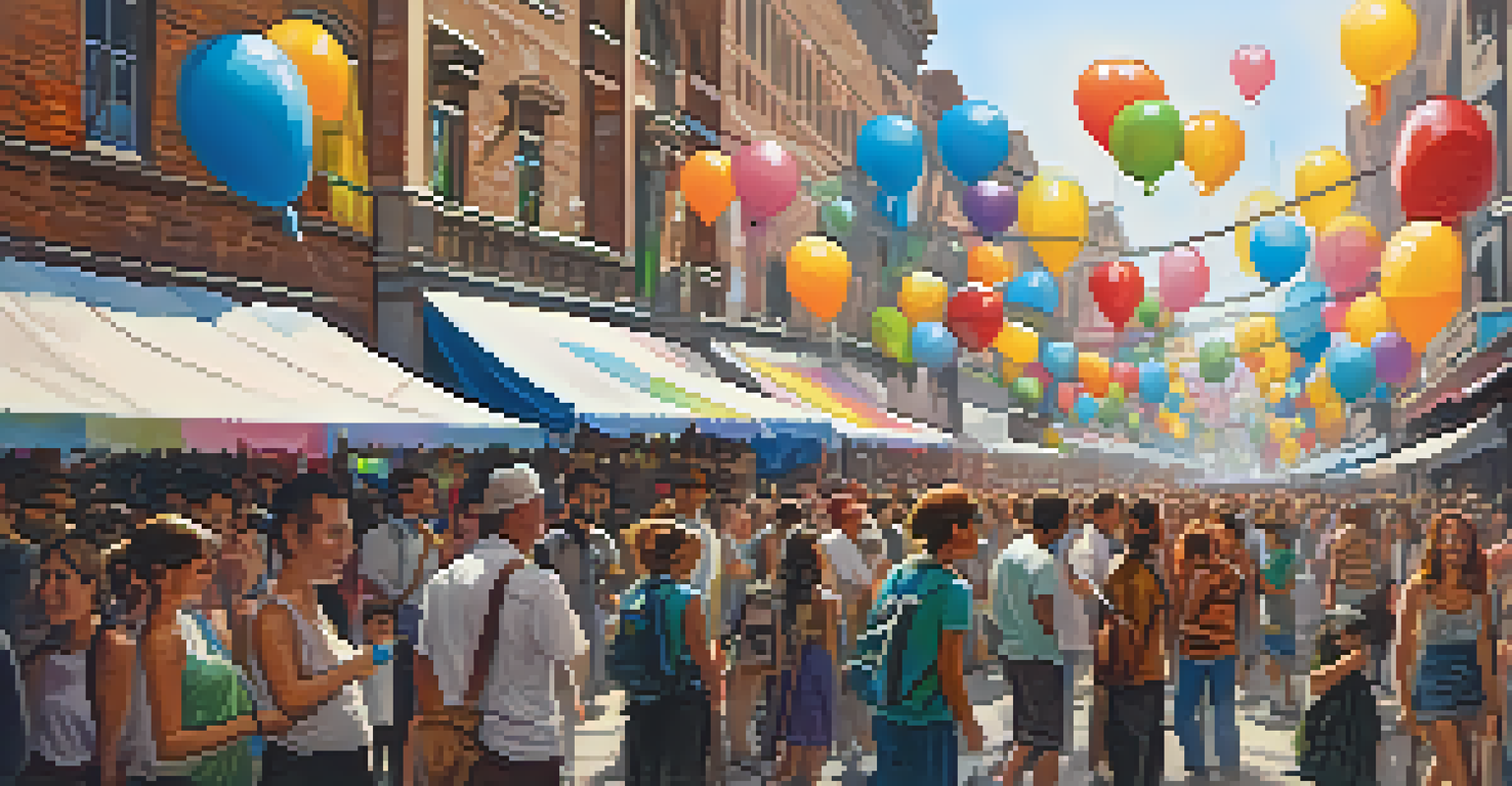California's Role in the Popularization of Street Art

The Birthplace of Modern Street Art: Los Angeles
Los Angeles is often hailed as the birthplace of modern street art. In the late 1970s, artists began to use the urban landscape as their canvas, creating vibrant murals that reflected the city's diverse culture. This movement was not just about art; it was a form of expression for marginalized communities.
Art is not freedom from discipline, but disciplined freedom.
One pivotal moment in this evolution was the rise of graffiti, particularly influenced by hip-hop culture. Artists like Keith Haring and Jean-Michel Basquiat paved the way by blending street art with fine art, making it more accessible to a wider audience. Their work challenged traditional notions of art and opened up opportunities for street artists.
As the 1980s progressed, the Los Angeles street art scene flourished, leading to iconic murals that still capture the imagination of locals and tourists alike. These vibrant masterpieces tell stories of social justice, cultural pride, and personal expression, showcasing the heart of the city.
The Cultural Impact of Street Art in California
Street art in California has transcended mere aesthetics; it has become a voice for social change. Artists use their work to address pressing issues such as racism, homelessness, and environmental concerns. Murals often serve as a visual commentary, urging viewers to reflect on societal challenges.

For instance, the famous 'Chicano Park' in San Diego is not just a collection of beautiful murals; it represents the cultural heritage and struggles of the Chicano community. Each piece tells a story, making the park a powerful symbol of identity and resistance. This illustrates how street art can foster a sense of community and pride.
Street Art as Social Commentary
California's street art serves as a visual voice addressing social issues like racism and homelessness.
Moreover, California's street art movement has inspired activism beyond its borders. The messages conveyed through these murals resonate with people globally, encouraging similar movements in cities around the world. This ripple effect underscores the transformative power of art in advocating for change.
The Evolution of Street Art Styles and Techniques
Over the years, street art in California has evolved dramatically in both style and technique. What began as simple tagging has transformed into intricate murals adorned with various styles, such as stencils, stickers, and paste-ups. Artists constantly experiment, merging techniques to create unique expressions.
The role of the artist is to make the revolution irresistible.
Take, for example, the rise of the 'wildstyle' graffiti, characterized by complex lettering and intricate designs. This form of art requires a high level of skill and creativity, showcasing the artist's dedication to their craft. Events like the 'Los Angeles Street Art Walk' have further popularized these styles, providing a platform for artists to demonstrate their talents.
In addition to traditional techniques, technology has also played a role in this evolution. Some artists now incorporate digital tools, allowing for greater precision and innovation. This blend of old and new keeps the art fresh and relevant, ensuring that California remains at the forefront of the street art movement.
The Role of Street Art Festivals in California
Street art festivals have become a vital part of California's art scene, showcasing local talent and attracting international artists. Events like the 'Pow! Wow! Long Beach' and 'ArtPrize' create opportunities for artists to collaborate and engage with the community. These festivals celebrate creativity while fostering connections between artists and residents.
During these festivals, the streets come alive with color and energy as artists transform blank walls into breathtaking masterpieces. Attendees not only witness the creative process but also participate in workshops and discussions, enriching their understanding of street art. This interaction helps demystify the art form and encourages appreciation.
Evolution of Styles and Techniques
Street art in California has transformed from simple tagging to intricate murals, incorporating both traditional and modern techniques.
Furthermore, these festivals contribute to California's economy by drawing tourists and art enthusiasts. Local businesses benefit from increased foot traffic, while artists gain visibility and opportunities for future projects. It's a win-win situation that highlights the importance of community support for the arts.
Street Art as a Form of Resistance and Identity
In many ways, street art in California serves as a powerful tool for resistance and identity. Artists often use their work to challenge societal norms and confront issues of oppression. This form of expression becomes a way for marginalized voices to reclaim their narratives and assert their presence in the urban landscape.
An example of this is the work of artist Shepard Fairey, whose iconic 'Hope' poster during the 2008 presidential campaign symbolizes the fight for change. Such pieces resonate deeply with communities, fostering a sense of belonging and empowerment. Through their art, these artists create a dialogue that encourages solidarity and awareness.
Ultimately, street art transcends mere decoration; it embodies the struggles and triumphs of various communities. In California, this has led to a rich tapestry of artistic expression that reflects the state's diverse populations and their shared experiences.
The Influence of Technology on Street Art
Technology has significantly influenced street art, particularly in California, where innovation thrives. Social media platforms like Instagram have become essential tools for artists to showcase their work and connect with audiences. This exposure not only helps artists gain recognition but also democratizes the art world.
Furthermore, advancements in digital tools have allowed artists to experiment with new styles and techniques. Some have embraced augmented reality, blending digital elements with physical murals to create immersive experiences. This fusion of technology and art keeps the movement fresh and engaging, attracting new generations of artists and admirers.
Festivals Boost Community Engagement
Street art festivals in California foster creativity and community connections while supporting the local economy.
As a result, California's street art scene continues to evolve, reflecting the dynamic nature of contemporary culture. The interplay between traditional techniques and modern technology ensures that street art remains relevant and impactful in today’s fast-paced world.
The Future of Street Art in California
Looking ahead, the future of street art in California appears bright, with continued growth and innovation on the horizon. As more artists emerge, we can expect to see a diverse range of styles and messages that reflect the evolving landscape of society. This evolution will likely address new challenges and celebrate emerging cultural trends.
Moreover, the increasing acceptance of street art as a legitimate form of artistic expression will further bolster its prominence. Institutions and galleries are recognizing the value of street art, often incorporating it into exhibitions and events. This shift helps to validate the medium and encourages more artists to pursue it professionally.

Ultimately, California's role in the popularization of street art will continue to inspire future generations. The blend of creativity, activism, and community engagement ensures that street art will remain a vital force in shaping the cultural narrative of the state and beyond.